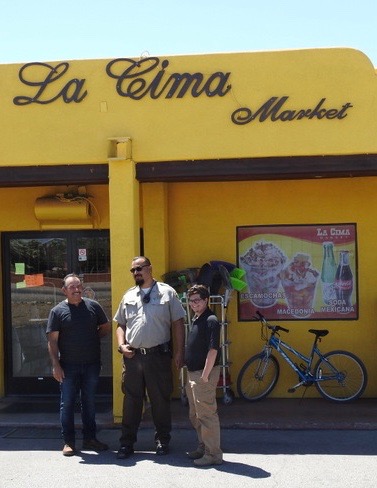Stitching Together the Fabric of Dogpatch
Story by Claire Sheridan | Photo by Claire Sheridan and Judith Clark
“The true measure of any society can be found in how it treats its most vulnerable members.” – Mahatma Gandhi
It is an area fraught with difficulty, a political no-man’s land, and it could perhaps even be called one of the remaining bastions of the Wild West: Dogpatch. For residents of Tucson, the name might ring bells; for those involved in the Animal Welfare Community here, it is a not-so-well-kept secret. While there are definitely problems in the neighborhood, the problems may not be what many think.
Summit, Arizona is a census=designated area south of the Tucson International Airport. To many, it will always be known as Dogpatch. There has been a fair amount of local media attention focused on terrible things that have allegedly happened to animals in Summit. Reportedly, groups of dogs routinely wander the neighborhood and barren desert beyond, and dead animals allegedly litter the area.
According to a 2010 Southern Arizona Animal Cruelty Task Force (ACT) Report:
During the height of the Summit View media frenzy, the Internet was flooded with stories of animals lynched from trees, subterranean dogfighting rings, grisly scenes of dogs with their heads bashed in with the “murder weapons” lying conveniently nearby, and strange ritualistic cruelty performed by unknown occultists. … After exhaustive attempts, no ACT enforcement agency [found] a single scrap of evidence to support the ‘animal cruelty conspiracy theory.’
Based on these reports, I was surprised by what I saw, or rather by what I did not see during three separate trips to Summit. Against a background of western music, I drove to Summit imagining a possible encounter with a modern-day Wyatt Earp. Things didn’t go exactly as I’d anticipated in Dogpatch. Having been cautioned that the area was potentially unsafe, and that packs of dogs roam freely, I wondered if the story of Dogpatch had already been told; I might be wasting time rehashing old news.
Surprisingly, the many residents with whom I spoke were genuinely interested in what I was doing, and, without exception, everyone I encountered was friendly and willing to talk to me. I did not feel unsafe when visiting the area.
Also, to my surprise, there were no packs of dogs. Driving extensively through the many dirt roads, twice with Animal Protection Officers and once on my own, there were no packs to be found. Even when we went looking for one that was reportedly just seen by a passing motorist who flagged down the dog truck, we were unable to locate a pack. There were some homes where multiple dogs were contained in the yard by fencing, but absent were the hunting packs, which reportedly feed on the carcasses of other animals.
And, although there were deceased animals along the area’s many winding dirt roads, there was a much higher concentration of other debris, including household trash. The several animals not contained by fences traveled solo, or were, at most, in pairs. They appeared to be unafraid of humans and too well fed to be strictly stray dogs. These were cared-for animals. During my childhood in a rural community, it was not unusual for people to know each other’s dogs because the dogs wandered, and these animals appeared much the same.
TNR for Dogs?
In Tucson, there is a movement to Trap, Neuter, Release (TNR) so-called “community cats.” These creatures are often feral, although they sometimes sidle up to their human benefactors when food is present. Some of the cats even go on to become owned, even becoming exclusively indoor pets. Almost no one, it seems, is horrified by the presence of these cats, which could otherwise be called “stray” cats.
Why are the dogs of Dogpatch any different? Are dogs valued differently than cats? Are there more people afraid of dogs, and therefore we must make every effort at dog containment? Leash laws notwithstanding, if multiple people feed a dog, and the dog wanders the neighborhood, could we not come to view this as a “community dog?” Could we come to concern ourselves more with the dog’s health status, and with the prevention of future generations of “community dogs” through a TNR program, based on the work already successfully being done with cats?
Talking With The Locals
Carlos Stahlkopff, owner of the area’s carniceria (butcher shop/convenience store) La Cima, has lived in Summit for over 25 years. He believes that Dogpatch’s dog problem comes primarily from dogs being dumped in the community by people who live outside the community— in fact, he has witnessed this phenomenon and reported it to the authorities at Pima Animal Care Center on numerous occasions. Although the dumping of dogs remains a fairly regular occurrence, Stahlkopff said that the problem reached a crescendo in 2007-8 with the economic downturn. He attributed the dumping of dogs then to people losing their homes and being forced to move into places where dogs were not allowed.
Stahlkopff looks through dumped piles of trash in an effort to locate identifying information about the folks who dumped it there. He reports the dumped trash to the authorities as well. On two occasions that he has called the Sheriff for emergencies at his home, including a break-in and someone threatening him, it has taken between 35 and 45 minutes for a deputy to respond. This is hardly surprising given that Pima County is over nine thousand square miles and the nearest Sheriff’s office is located far from Summit. Clearly, Stahlkopff loves his community, and is willing to work to make it a better place to live. La Cima is a hub of the neighborhood; its owner could easily be Summit’s unofficial mayor.
Rhonda Redmon has seven or eight dogs; she herself has lost track, but she does know that all are spayed or neutered, vaccinated and contained within her fully fenced backyard. She calls them her “refugees.” She said, “People just drop them off out here. It’s crazy.” All of her dogs have, in one way or another, been rescues. A reason for losing count is that one rescue was pregnant when Redmon took her in; the momma dog has had her litter, some of which have since been adopted.
Martha Montenegro and her husband have four dogs between them. They attended the free vaccination outreach event hosted by Angels for Animals Tucson. Three of the four have already been spayed or neutered. They used to have a female German Shepherd, but she was stolen from their yard earlier this year. The Montenegros’ daughter rescued a nine-month-old Boxer, Hennessy, from people who were using the dog to practice tattooing. When their daughter was forced to move, they adopted Hennessy.
Calling All Angels:
In December 2009, Nancy Maddry responded to an ad on Craigslist about a horse in Summit. Little did she know that rescuing this horse would lead her down the path to helping dogs. After witnessing the living conditions of numerous animals, Maddry sprang into action, visiting the area by herself several times weekly to rescue animals, provide food and water and do outreach in the community.
Since then, Angels for Animals Tucson has been assisting Summit residents with free vaccination outreach events, providing information on spay and neuter programs and providing food to dog owners. They have placed approximately 200 dogs removed from the area into permanent homes. At the Angels’ monthly community outreach event in May, using only a pair of tents and several folding tables, the group administered 47 parvo/distemper vaccinations, provided basic grooming of nails and distributed dog beds, collars, leashes, food and treats.
A Matter of Resources:
With the nearest pet supply store and veterinarian located a good 20-minute drive from Summit, the resources necessary to care for pets in a manner consistent with mainstream American media portrayals of good care, are simply nonexistent. The question is: Does that mean that the residents of Dogpatch do not care for their animals?
For Animal Protection Officer Daniel Robledo, the answer to that question is no. In his 11 years at Pima County Animal Protection and 5 years working for Animal Protection in Los Angeles, Robledo has seen more than enough animal neglect, abuse, and cruelty to last a lifetime. Yet, this man remains a gentle giant of sorts. At well over 6 feet tall, Robledo’s stature affords him an imposing physical presence. However, the key to his effectiveness is not his ability to intimidate and enforce, but rather to meet people where they are.
Growing up poor in a difficult neighborhood of East Los Angeles, Robledo Fabric of Dogpatch Resident Rhonda Redman with some of her “Refugee” Dogs Long-time Angels Volunteers Nichole and Jayson care for two puppy customers at Angels Outreach event Hennessy & Commander with their human, Martha Montenegro’s Husband Martha Montenegro with Piwi and Tito was a self-described bad boy. His own experience allows him to identify with the people of Summit, and he communicates a profound respect for their way of life. Where some might see a ramshackle hodgepodge of dwellings, as we drove through the streets, Robledo pointed out the progress residents have made in building their homes. He remarked that Summit is a neighborhood where residents take care of each other. In his experience, Summit is very family-oriented; even though residents themselves might not have much, it is a neighborhood where “you won’t go hungry” if you are in need.
Although he has seen cruelty cases in Summit, Robledo said that the biggest problems in Dogpatch come from a lack of education and resources. Outreach efforts to educate the community about the benefits of spaying and neutering pets are in progress through Pima Animal Care Center (PACC), and PACC is also working to provide basic animal care necessities, including fencing, to help people keep their pets at home.
Language can be a barrier to overcome, as many of the residents speak only Spanish. Robledo is one of several Spanish-speaking Animal Protection Officers; Summit is an area where his bilingualism is a huge benefit to his work. In his experience, it is much easier to understand the nuisances of a situation by speaking to the people involved in the language they understand best; for many residents of Dogpatch, that language is Spanish.
PACC is attempting to remove dangerous and aggressive stray dogs from the area. Robledo said that a handful of known aggressive stray dogs cause the majority of the problems reported to PACC. Unfortunately, a lack of containment in fenced yards has meant that efforts at trapping the dogs that are known to be aggressive often result in inadvertently trapping cared-for animals who’ve wandered out of their yards. Enticed by the food and water in the traps, or perhaps merely curious, these pets are not the intended targets of the trapping effort. It takes more time to figure out where these pets belong than it would to round them up and haul them to the shelter.
During my ride-along with Officer Robledo, his trap was sprung twice by dogs that were clearly pets. Robledo found where the dogs belonged. His effort meant that someone didn’t lose a pet, and also that the dogs were only mildly inconvenienced by the experience, instead of finding themselves in the completely foreign environment of a kennel at PACC.
By The Numbers:
1,016,206 people reside in Pima County; the median household income is $47,560. There are an estimated 254,052 total dogs, of which 78,858 are believed to be neither spayed or neutered.
Within the City of Tucson, there are 527,972 residents, and the median household income is $38,155. Tucson has an estimated 131,993 dogs, of which 50,791 are not believed to be either spayed or neutered.
Summit (Dogpatch) has 5,097 residents, and the median household income is $28,935. There are an estimated 1,274 dogs, of which 587 are not spayed or neutered (1).
Based on data from the International Monetary Fund World Economic Outlook dated April 2018, 119 of the 192 (62%) countries for which statistics are available have a Gross Domestic Product that is LESS than what Americans spend on pet care (2) . That means that the total value of ALL of the goods and services produced by each of 119 different countries doesn’t measure up to the money we spend on our pets in the US.
In 2017, Americans spent $69.51 billion on pet care; this year it is predicted that the expenditures will reach $72.13 billion. As a comparison, the United States Department of Education’s discretionary budget for 2017 was $69.4 billion (3). We spend more money on caring for our pets than the money spent on educating our kids. Even when you consider that 68% of American households own a pet (4), this figure seems high. Is it possible to care for pets as well without spending a fortune? Alternatively, if you don’t have a fortune to spend, does that make you an unfit potential pet parent?
Changing of the Guard at Pima Animal Care Center (PACC)
Pima Animal Care Center is working to build new relationships within areas of the community like Summit. Where previously the focus was on enforcement and ticketing, today there is an effort to understand how best to help people keep their pets happy and healthy.
PACC provides resources such as pet food, medical attention, free vaccination clinics; they provide outreach education about the benefits of spaying and neutering pets, and they even help with things like fence building to contain pets at their homes in Dogpatch.
According to Director Kristen Auerbach, “Just six years ago, PACC was taking in nearly 25,000 animals and less than half of them were making it out of the shelter alive. We were operating under a ‘pound’ model, which meant we were totally reactive. We saw loose dogs, we rounded them up and brought them to the shelter without much thought about the long-term consequences. What we found, after decades of this approach, was that it didn’t work. The endless intake of homeless pets never stopped. It was costly, ineffective, and deadly for most of the animals. About five years ago, we began changing our approach in an effort to actually get to the root causes of the problem. These root causes are about people – people who don’t have the means to provide medical care for their animals; people who can’t afford to or are unable to fix their fences; people that don’t know the rules and expectations around responsible pet ownership. Instead of rounding up pets from underserved areas, we’ve taken a different approach, focusing our resources on rescuing the pets facing true cruelty and neglect, helping to educate the community, and providing resources. We have microchip clinics, free spay and neuter services provided by partner groups, rabies vaccine events. We help people be better pet owners because this investment in people and animals – this proactive approach – has results that go far beyond any one animal. It’s working. Last year, we took PACC Animal Protection Officer Robledo checks a trap set to catch strays in Summit in around 16,000 pets and saved nearly 90% of them. This year, we’re planning to do even better. Our pet support services department is now working in places like Dogpatch to help the community take better care of their pets and keep them contained. We know that for the vast majority of people, pets are their family members and at PACC, we are committed to giving people the helping hand they need to do good by their animals.”
While problems persist in Dogpatch, the efforts of many people have begun paying off, and progress is evident. Maybe someday the neighborhood will be known strictly as Summit, but in the meantime, the patchwork that makes up the community will continue to have lots of dogs.
For information about how you can get involved in this and other community building efforts at PACC, please contact Bennett Simonsen, Animal Protection Supervisor: Bennett.Simonsen@pima.gov
PACC will host a community meeting to discuss Dogpatch on Thursday, July 26th at 5:30 PM in their Community Room. Anyone interested in learning more and/or lending a hand is encouraged to attend.
PACC is located at: 4000 N. Silverbell Rd., Tucson 85745
Check out Angels for Animals Tucson @: www.angelsforanimalstucson.com
(1)Source: Pima Animal Care Center
(2) Source: Statistics Times http://statisticstimes.com/countries-by-projectedgdp.php
(3) Source: https://ed.gov/about/overview/budget/budget17/budget-factsheet.pdf
(4) Source: American Pet Products Association http://www. americanpetproducts.org/press_industrytrends.asp














